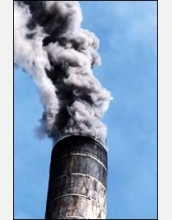|

Press Release 05-042
U.S. Exports Nitrogen Pollution Elsewhere

Europe’s deposited close to sources
March 15, 2005
The United States is exporting nitrogen pollution beyond its borders, and some may even be reaching western Europe, according to a recent data analysis by scientists at the National Center for Atmospheric Research (NCAR) in Boulder, Colo. and the University of New Hampshire. At the same time, however, most of the nitrogen pollution produced in Western Europe is deposited within its own boundaries.
Nitrogen emission and deposition have accelerated significantly over the past century and a half, especially in the Northern Hemisphere, thanks to a combination of human population growth, fossil-fuel consumption, deforestation and intensified agriculture. The result is higher levels of nitrogen entering the atmosphere in trace gases, notably nitrogen oxides (NOx) and ammonia (NH3). These pollutants are best known for their role in the formation of acid rain, which damages lakes and ecosystems, and in the creation of ozone, which harms living tissue and decreases plant production.
Trace gases hard to track because they are often blown downwind, and can travel for long distances before the gases and their reaction products are washed out by rain or snow or deposited in a dry state on Earth’s surface. Nitrogen compounds emitted in the United States, for example, are often blown eastward and deposited on the surface of the Atlantic Ocean—or beyond.
To quantify this process, the NCAR researchers used the limited number of network observations available over land, together with mapping techniques and computer models of chemical removal, to map nitrogen emission and deposition in the United States and Western Europe from 1978 to 1994. The study was funded by the National Science Foundation (NSF) and published in the February issue of the journal Ecological Applications.
The scientists found nitrogen deposited in the United States was mainly in the form of compounds produced by fossil-fuel burning. However, the amount of nitrogen found deposited here was only 40 percent of the levels emitted into the atmosphere. Between 5.30 and 7.81 million metric tons (5.83 and 8.59 million U.S. tons) of total NOx and NH3 were unaccounted for. The difference that suggests nitrogen-containing gases were being transported beyond U.S. boundaries.
Or to put it another way, says lead author Elisabeth Holland of NCAR, "the United States is exporting nitrogen.” Indeed, she adds, "there’s some evidence that a portion of the U.S. nitrogen pollution may be ending up in Western Europe”—although more research will be needed before scientists can say how big that fraction is.
In contrast, Western Europe received five times more nitrogen in precipitation than the lower 48 states during the study period, with nearly that much deposited on the surface there. Most of the nitrogen found in deposits in Western Europe was in the form of compounds produced by farming and animal husbandry. The results suggest most of the nitrogen emitted in Europe was deposited there.
The authors caution that their results are only estimates. The data were gathered from an observation network originally set up to measure the effects of acid rain on rural and remote regions. The sparsely scattered U.S. sites, situated far from cities, may be under-measuring nitrogen deposition from urban emissions, they say.
The study was also funded by the Department of Energy, NASA, and Germany’s Max Planck Institute for Biogeochemistry.
NCAR’s primary sponsor is the National Science Foundation.
-NSF-

Media Contacts
Cheryl L. Dybas, NSF (703) 292-7734 cdybas@nsf.gov
Anatta , UCAR (303) 497-8604 anatta@ucar.edu

The National Science Foundation (NSF) is an independent federal agency that supports fundamental research and education across all fields of science and engineering. In fiscal year (FY) 2009, its budget is $9.5 billion, which includes $3.0 billion provided through the American Recovery and Reinvestment Act. NSF funds reach all 50 states through grants to over 1,900 universities and institutions. Each year, NSF receives about 44,400 competitive requests for funding, and makes over 11,500 new funding awards. NSF also awards over $400 million in professional and service contracts yearly.
 Get News Updates by Email Get News Updates by Email
Useful NSF Web Sites:
NSF Home Page: http://www.nsf.gov
NSF News: http://www.nsf.gov/news/
For the News Media: http://www.nsf.gov/news/newsroom.jsp
Science and Engineering Statistics: http://www.nsf.gov/statistics/
Awards Searches: http://www.nsf.gov/awardsearch/
| 

